Menu
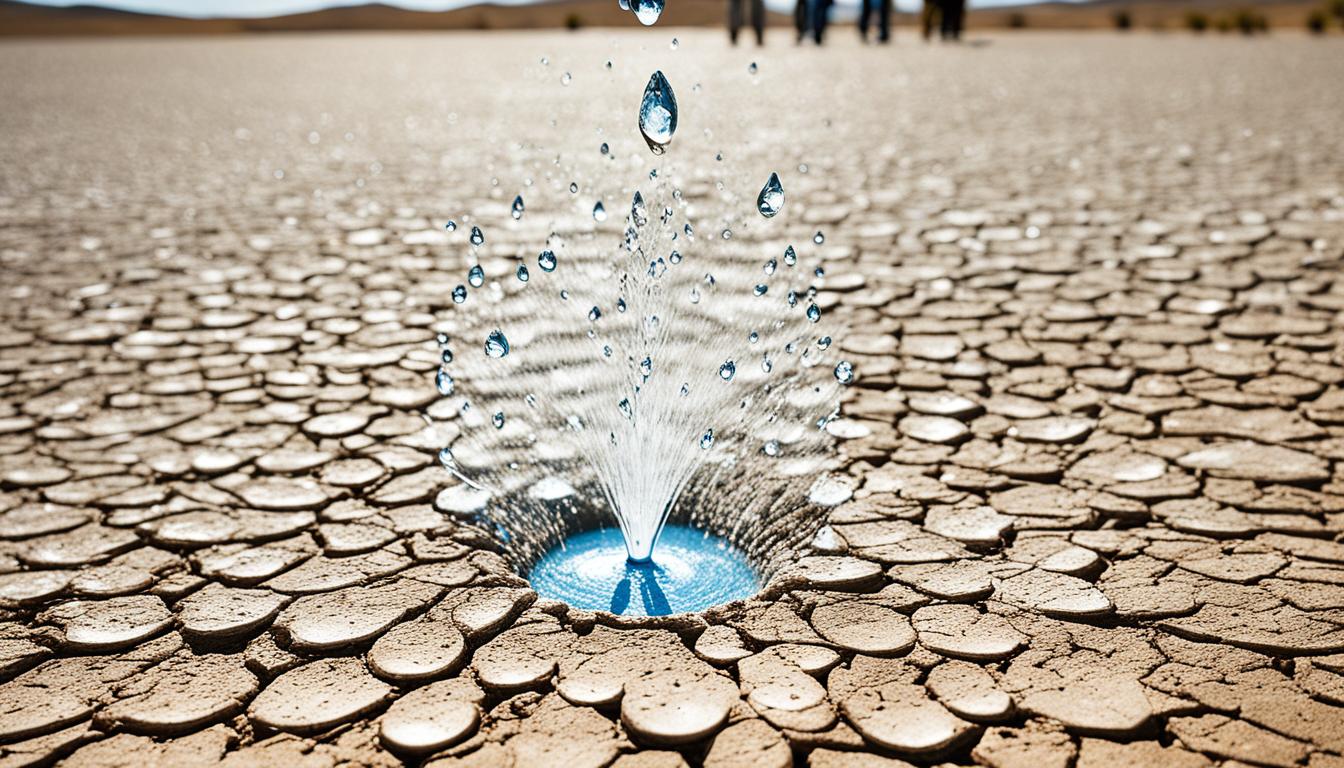
Only approximately 3% of Earth’s water is fresh water. Sadly, just 1.2% of that is drinkable. This tiny sliver of water available for use points to a global water scarcity issue.
And this scarcity affects about 40% of the planet’s people. This shows the critical need for effective water management policies. The goal is to ensure fair and smart use of the available water.
It’s vital to really get water management policies. Why? Because the demand for water is rising rapidly, and the supply is limited. Experts say we face a serious problem unless we act now.
So, we must learn from those who understand water governance. By doing this, we can use water wisely, protect it, and keep our ecosystems healthy. This approach is learned through case studies and expert thinking.
Water scarcity is a big issue in the U.S. It greatly affects how much water cities and farms can use. The states in the west and central areas, around the Colorado River and Ogallala Aquifer, feel the most strain. This is because they need a lot of water.
This problem isn’t just about less water. It’s also linked to social and economic challenges. For example, 2.2 million people in the U.S. don’t have running water or plumbing. Many more don’t have good sanitation. Latinos, Blacks, Indigenous people, immigrants, and those living in poor areas are hit hardest.
People without enough water spend about $1,350 a year on bottled water. This cost is a big deal for everyone. In total, the U.S. loses about $8.58 billion a year because of water issues. This is due to problems like less work, lower earnings, and more spent on health. Over 15% of the Navajo Nation lacks household water, showing how big the problem is.
| Group affected | Impact |
|---|---|
| Latino, Black, and Indigenous communities | Poor water and sanitation systems |
| Immigrants and low-income individuals | Higher vulnerability to water insecurity |
| Residents of Jackson, Mississippi | Failure of water treatment facility in 2022 |
| Women and girls | Increased risks related to water collection and access |
The need for water is causing tensions in many places. Problems like pollution make things worse. The water plant breakdown in Jackson, Mississippi, for instance, left 150,000 people without clean water. This shows how fragile our systems can be and how it affects people.
There’s a real challenge in meeting everyone’s water needs. We must work together for solutions. Using smart technology, sharing information, and creating more awareness can help. This way, we can overcome the water challenges and build a better future for everyone.
Water conservation policies are key in tackling water scarcity. Today, over 40% of people face water shortages worldwide. Thus, we need strong policies to protect our water. These rules aim for effective water use. They make sure that less than 3% of all water is wisely used.

Using water wisely involves many steps. These include better irrigation, smart technologies, and clear rules. Water experts say such steps can help in cities and the countryside. They encourage using tools that save water and support a lasting water use.
For places like India and parts of Asia, where water needs are dire, these steps are crucial.
Local people are pivotal for good water policies. By teaching and involving them, we can save more water. Studies show that when groups work together on water projects, good things happen. Water experts and local stories point out how water saving helps the economy, culture, and nature.
Understanding the importance of water conservation depends on everyone getting involved. If we all take part, we can make a big difference. This shows that changing policies and improving water systems is a must to save water for the next generations.
Sustainable water management aims to keep our water use in balance. It ensures water lasts for us and for future generations. We aim to make 20 to 50 litres of clean water usable each day for everyone. This must happen without hurting tomorrow’s water availability. Efficient and thoughtful use of water is key. This means looking at water’s place in our natural world, our society, our past, and our economy.
Looking after groundwater is crucial as it makes up more than half of the world’s fresh water. It’s used for drinking and cooking, making it super important. Farming uses the most water around the globe. To use water more wisely, farmers should try precision farming. This helps grow more food with less water. For cities, special plans are needed to save water because more than half of us now live in urban areas. Places like Spain and China are leaders in recycling water. They show how using new methods can help keep our water supply going.
Businesses and the energy sector use a lot of water – about 20%. To help, they need to use water more carefully. Our towns and cities use about 10% of the water globally. They, too, must use it wisely. Our world’s environment is asking for help, so it’s time to find better ways to save water. Let’s start with saving more rainwater and using smarter ways to water plants. This will really make a difference.
Let’s take a look at how the Inland Empire Utilities Agency managed water challenges in 2016. They got top marks for their efforts. It shows that when people work together, they can really make a difference. The SWM Profile, a tool made with the help of the Sonoma County Water Agency and the Inland Empire Utilities Agency, is a great example. It helps show where water systems need to improve. This lets everyone involved work better together.
China has done great work in reusing water. From 2010 to 2017, they were part of almost half of the major water reuse projects in the world. This shows that bringing together our needs with smart ideas can have big payoffs. In 2019, the Water Foundation highlighted this work. They encouraged others to learn from these projects. The goal is to save more water and get more people involved in caring for our water supplies.
Managing water in cities is very tough, especially with more people moving in and the changing climate. A key issue is how to tackle stormwater. In the US, over 772 places use combined sewer systems. This often leads to unsightly problems like 75,000 times a year, waste is released into the environment. This shows the urgent need for better ways to manage stormwater to keep our water clean.

Another big problem is water escaping from the pipes. Every year, about 2.1 trillion gallons of clean water is lost in the US from leaks. It’s not just a problem there; leaks make up to 23% of water use in places like the UK and EU. In some poorer countries, this loss can be as high as 70%. This shows that the issue is global.
Also, cities often don’t have enough money or people to make things better. Because of tight budgets, they can’t fix their old water systems or hire more staff. This leads to a cycle where things get worse and worse. Adding to this, the weather changes are making the water systems of cities weaker, which can lead to problems like pollution and sudden shutdowns.
UNICEF notes that water problems in cities are caused by several things, including too many people, bad water use, poor management, and a fight for water between different groups.
All these issues underline the need for strong plans and actions to fix how we manage water in cities. We must create systems that can handle more pressure and keep water sustainable for future generations.
| Country/Region | Estimated Annual Potable Water Loss |
|---|---|
| United States | 2.1 trillion gallons |
| UK & EU | 23% of public water supply |
| Low-Income Countries | Up to 70% of public water supply |
Integrated water management (IWM) joins many players and looks at water resources in a complete way. Its main strength is bringing together different groups to work at every level. This way, water handling gets more coherent and effective, unlike old, separated methods.
IWM boosts water system efficiency by blending various sources of water. This includes surface water and groundwater. Different experts work together, like planners and engineers, to find creative local solutions. It ensures fairness in water use for everyone and helps nature by meeting both human and ecological needs.
Many real-life examples show the benefits of integrated water management worldwide. By using both traditional and modern methods, like combining storm sewers and green infrastructure, cities improve water quality and adapt better to growth. Efforts like River Basin Organizations’ work show how IWM helps share water resources fairly and avoids disputes.
Cities, dealing with tough problems like stormwater and water pollution, benefit a lot from integrated water approaches. They involve the whole community and decision-makers. This leads to stronger water systems, showing the full aspects of integrated water management.
Moving towards integrated water management is a major change in how we manage water. It shifts us from single, divided efforts to joint, all-round solutions. This highlights the continuing need for smart teamwork and creative ideas to handle water problems now and in the future.
Water governance strategies are crucial for managing and sharing water resources. They use social, economic, political, and administrative plans. These help decide on water access, fair use, and avoid conflicts.
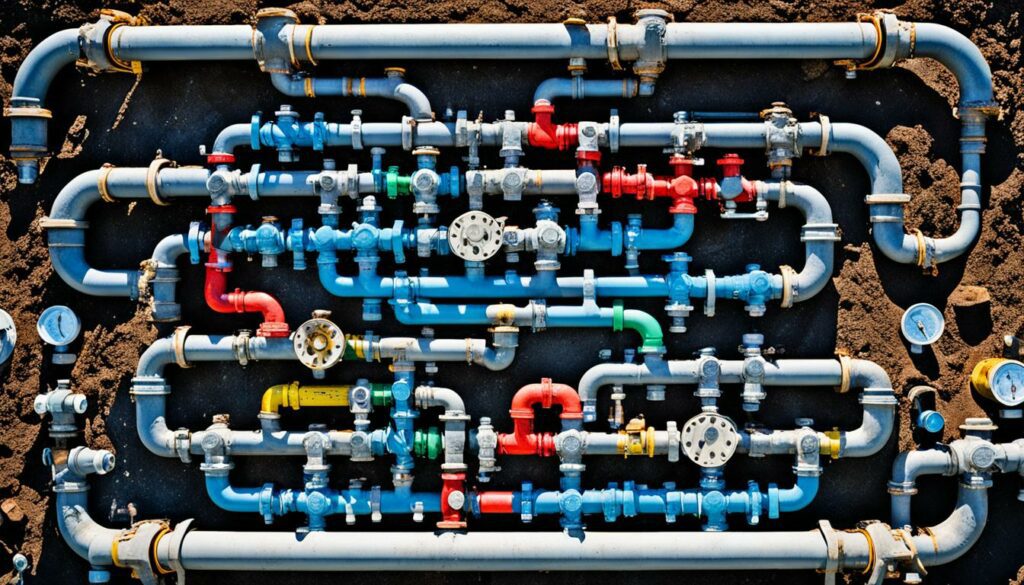
Creating strong water policies is key to solving many water issues. They assign duties to governments, groups, and businesses. This aims to fight problems like misuse, corruption, and slow changes.
A solid plan supports fair water use and safety. This could pull in more investments for better water systems. It also lowers risk for those investing.
Working together is vital for making water governance open and based on facts. It pulls in different organisations and people. This ensures complete solutions to water problems.
Groups such as the Food and Agriculture Organization lead in updating water use and protecting water sources. They work in areas like irrigation and managing water quality. These efforts take a team with good water tracking and laws in place.
Partnerships with global groups like the United Nations Environment Programme are key. They help set up guidelines for water care. This makes water quality better and controls pollution.
Water governance is crucial for tackling climate change, feeding people, fighting poverty, and saving nature. The right plans are essential for successful water management.
Water management policies and climate change are deeply connected. The latter makes the challenges in water ecosystems worse. The aim of the Water Framework Directive (WFD) of 2000 was a good ecological status in all water bodies. But it didn’t talk about how water ecosystems should adapt to climate change. The 2007 EU Floods Directive (FD) focused on dealing with floods and how they’re influenced by climate change.
In 2007, the European Commission highlighted water scarcity and droughts. In 2012, they issued a plan to protect Europe’s water resources. This plan pointed out the importance of managing droughts and the effects of climate change in River Basin Management Plans (RBMPs).
Climate change is making southern Europe less able to get water, causing not only less water but also more often droughts. A report in 2020 confirmed this.
In 2021, the World Meteorological Organisation mentioned a shocking stat. It said that only 0.5% of the Earth’s water is fresh and can be used. But this water is at risk because of climate change. Every year for the past 20 years, the freshwater on land has gone down by 1 cm. This is making water security a big issue.
We need to act fast to adapt the water ecosystems. This means making systems that can handle the climate changes better. By 2050, more people will be in danger from floods and water-scarce areas. These changes are happening. The United Nations talked about 2020 in their report.
It’s very important to put in place water policies that think about the future. The new Regulation on water reuse from 2020 asks for more water to be used in farming. The Drinking Water Directive has also been updated to think about climate changes when checking if water supply is safe. These policies are steps towards making our water systems ready for climate change.
Understanding the impact of how we manage water is key. We need to keep our water safe and our nature healthy. This means dealing with issues like water pollution and protecting water habitats.
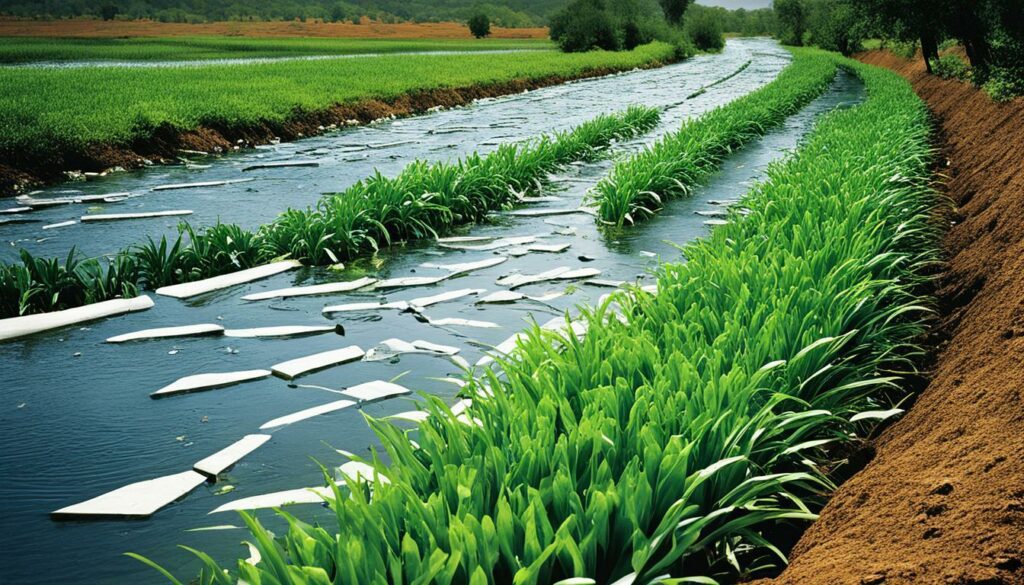
Handling water pollution is vital for protecting our environment. It messes up the lives of water plants and animals, and it affects us too. When it rains a lot, sewage systems can’t cope, and bad stuff gets into our water. The World Bank is working with countries to fight this, showing how serious it is globally.
Keeping our waters and the life in them healthy is top priority. These water worlds give us clean water, help prevent floods, and let animals and plants thrive. We need to make sure we can adapt to changes and take long-term actions to protect these areas. The Water Security group stresses the need for plans that last, ensuring our watery places stay safe.
Over the last twenty years, we’ve been losing the ability to store water on land by 1 cm each year. More and more people will be going without enough water by 2050. This shows why we need good water plans now more than ever.
It’s important to look back at how people managed water in the past. This helps us see how we protect water now. About 50,000 years ago, humans spread across different lands. They often dealt with diseases from dirty water. This showed them the value of clean water, even back then.
About 10,000 years ago, people started farming. This made them live in one place, making more towns and cities. In Minoan and Mycenaean Crete during the second millennium B.C., they had advanced ways to get and use water. They had baths, toilets, and ways to drain water. These ideas laid the foundation for future water work.
Around 470 B.C., Alcmaeon of Croton, a Greek doctor, saw a link between clean water and staying healthy. This was a big step in understanding the importance of clean water. The Greeks and Romans used methods like settling tanks and boiling water to make it safe.
In 1952, the start of Resources for the Future (RFF) marked a key point in water research. It led to ideas like effluent taxes, which were a smart rule to save money and protect water. This shows how we’ve moved from old ways to new ways of handling water.
The Clean Water Act of 1972 was a big deal in keeping water clean. It was thanks to people like Nathaniel Wollman and Gilbert Bonem who made plans for the future’s water use. Their work really made a difference.
Looking at how we’ve handled water in the past teaches us a lot. While we’ve come far with technology and rules, the basics from history still help us take care of water today.
Economic factors are key when making water policies. They influence decisions related to funding for water resources. Experts look at benefits and costs closely to judge what water policies are best.
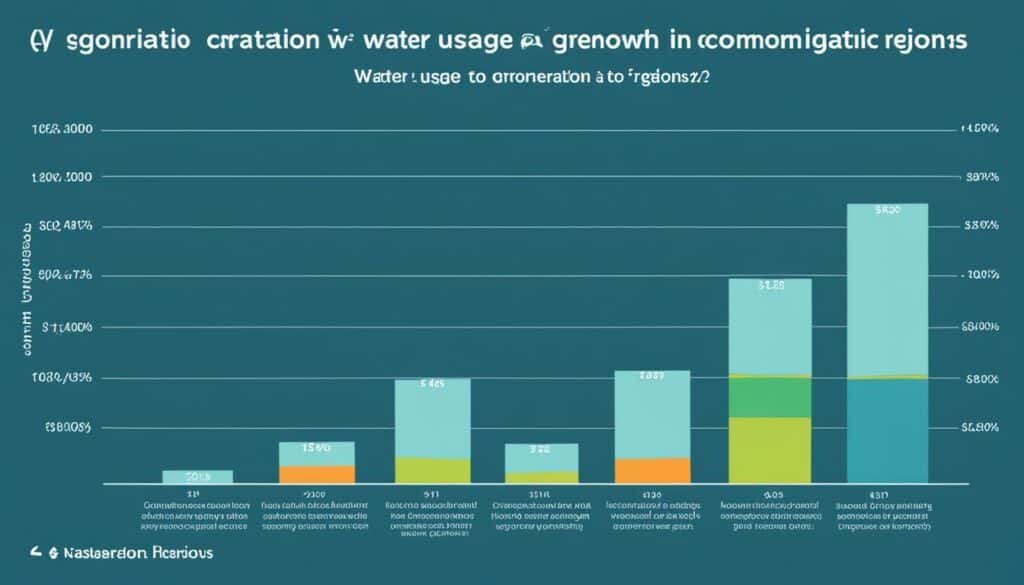
Dealing with money is big for water institutions. They’re always trying to find enough money and spend it wisely. Putting money into water and sanitation helps fight poverty and boosts the economy.
Having clean water and sanitation helps the poor stay healthy. It also lowers the amount spent on healthcare. But, finding money is tough because there are many important things where money is needed.
Encouraging saving water with economic means is very effective. Water use is managed through prices and ownership rights. Using plans that don’t physically change water sources also helps.
Systems that let water rights be bought and sold often work well. This shows the real cost of using water. It helps use water better and encourages saving water.
| Country | Water Rights System | Key Features |
|---|---|---|
| Chile | Tradeable Property Rights | Allows trading between sectors and resolves conflicts at local and national levels |
| United States | Prior Appropriation | Water rights given to the first user, beneficial use required |
| Spain | Public Administration | Regulated by administrative agencies, ensuring equitable distribution |
The world of water management is changing fast because of new technology. A study looked at 3771 startups from around the world. It found eight big trends in how we’re using water. These include areas like digital management and ways to make water use more efficient.
Key water management trends:
New tech is making big changes in how we protect our water. PipePredict can find leaks before they happen using smart analysis. And SPHERAG is using cloud tech to make sure crops get the exact water they need.
Looking at water in a more sustainable way, Oxyle has a special filter that makes dirty water clean. Algaesys is using algae to clean water naturally. These new ways show how tech is making a difference in how we use water.
WarraniumMBR is cutting edge in how it filters water. And Nanoseen makes special filters that clean water with no extra energy. These are some of the top stories in water tech from 2023.
Countries like The Netherlands and the US are doing a lot in new water tech. They’re using smart systems to use water better, like in farms. These show smart ways to work with water without wasting it.
Some places are finding clever ways to reuse water. In Denmark, the Green Solution House uses smart designs to use very little water. It shows we can live and work without using up too much of the earth’s water.
Cities like Barcelona and regions like California are working hard to save water. They use big data and new tech to use what water we have better. This is really important because of the challenges of climate change.
Some places are farming smartly to save water and grow food for cities. Dubai and places like Kalundborg in Denmark reuse water smartly. These are good examples of how we can use water without harming the environment.
All these examples show how much we can do with new water tech. They show we can live and work in ways that are good for water and for the planet.”>
Having solid legal frameworks for water management is key. It helps make sure we use water fairly and in a way that lasts long. These rules form the basis for fair policies. They take into account what different people need, follow world norms, and match what our country wants.
In 2010, the United Nations said clean water and sanitation are human rights. This shows why strong water laws are so important. They should cover water quality, how it’s shared out, and how we use it. In the United States, laws like the Clean Water Act and the Safe Drinking Water Act help protect water. But, these laws have to change sometimes to deal with new problems and weather changes.
Water laws can change how we use water a lot. They make sure water meets safety rules from groups like the WHO. Laws also help stop water pollution and encourage looking after water and sewage in a smart way. They show that water is important both for people and for making money. This makes it clear what each person or group should do about water.
Working with lots of people is key to making water laws work well. This means none-government groups, locals, and small groups should all share their thoughts. Sometimes, we need to change laws to keep up with new water and hygiene needs. Having good, up-to-date laws is very important in taking care of water for the future.
Public-private partnerships (PPPs) are key to better water management. They help join public and private funds to build lasting water structures. In Florida, they tackle tough water issues well.
In Florida, the state’s government guides the work on water. The Florida Department of Environmental Protection and water management districts focus on sustainable water use. PPPs are active in important water projects on private lands. They get landowners involved by offering benefits. This is a big part of their success.
In South Florida and the Northern Everglades, success stories show PPPs work. They help store water and keep it clean. Plus, they protect animals and plants. Funding from Florida’s government and water management districts keeps these projects going.
Florida’s legislature and the WMDs have been strong supporters of PPPs. They help in storing water, improving its quality, and refilling aquifers.
One great thing about PPPs is how they set up long-term deals. They run for 10 years with yearly money. This makes sure the work keeps happening. But, there are still problems to solve, like finding money every year. And making sure landowners stay willing to help.
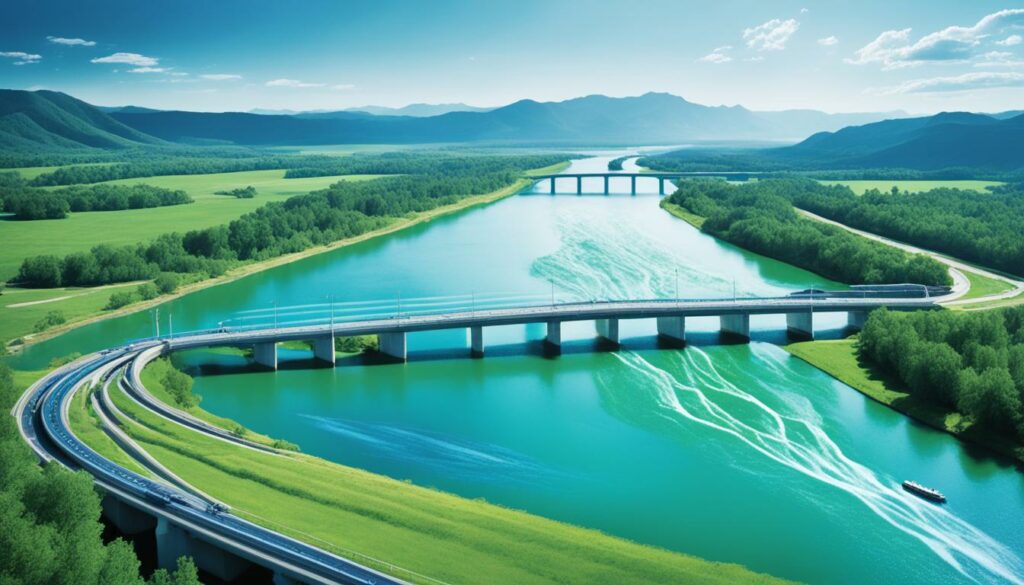
PPPs have been helping with water and other city needs since the 1990s. Even though they only make up a small part of spending, they do a lot. In 2017, the US spent $441 billion on transport and water. PPPs were 1 to 3 percent of this.
PPPs are good at getting projects done faster and with new ideas. While they sometimes face challenges, they generally do very well. They help meet rules and spend less money on repairs.
The success of PPPs in water work shows we should keep supporting them. This will help build and keep up with water needs well.
| Program | Focus Areas | Key Outcomes |
|---|---|---|
| FRESP (South Florida) | Water Storage, Quality Improvement | Enhanced Aquifer Recharge, Species Conservation |
| NE-PES (Northern Everglades) | Groundwater Recharge, Water Quality | Improved Water Treatment, Protected Species Refugia |
The world needs new ways to manage water. Many case studies show success and failures. They teach us valuable lessons.
Texas highlights the importance of managing water well. The Hays Trinity GCD, starting in 2001, manages water for 46,000 people. They rely on private or public wells for water.
Jacob’s Well, under the GCD’s care, is vital for Cypress Creek. Besides supporting water flow, it makes money from tourism. In 2010, it brought around $65 million to Hays County.
These stories show how science and community work can help the environment and economy. The technical committee for Jacob’s Well is a good model. It shows how working together leads to better water management.
Handling water is hard, as shown by problems during the 2011 drought. Many wells went dry, and Jacob’s Well has stopped seven times since 2000. These challenges highlight the issue of water scarcity.
About 1.2 billion face a water shortage. Over 1.6 billion deal with water scarcity’s economic impact. The world needs better water management.
The level of harmful chemicals in water is a concern. 80% of used water goes back without treatment. This means we need better policies and plans to protect our water.
| Case Study | Success Indicators | Challenges |
|---|---|---|
| Hays Trinity GCD | Groundwater support, tourism revenue | Wells drying, water scarcity |
| Jacob’s Well | Sustainable spring management, tourism | Drought impact, chemical safety limits exceeded |
By learning from failures, we improve. By studying both successes and struggles, we can suggest better water management.
Looking ahead, understanding the future trends in water governance is vital. StartUpInsights studied over 3700 startups worldwide to spot these trends. The findings are both exciting and call for action, pushing for improved water policies.
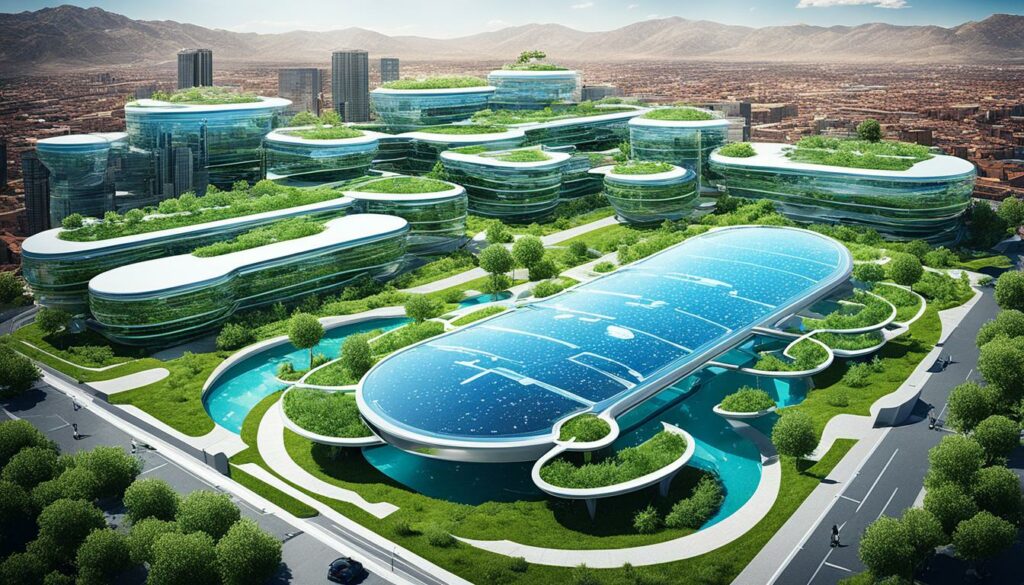
Digital Water Management, Wastewater Processing, and Advanced Filtration top the list of trends. Digital Water Management, with AI and IoT, is the leading game-changer. It brings smart systems, like real-time monitoring, into water management.
Let’s look at some startups making a difference in these areas:

These new ideas stress the importance of flexible water strategies. We need to be open to new tech and ways of thinking. This will help us build lasting, efficient ways to manage water.
Startup trends show the US and the Netherlands are key players. They have strong environments for new water solutions. This shows how new and old ways of working with water can come together through innovation.
Looking forward, we must adapt to new tech and markets. By learning from global innovation, we can strengthen our water policies. This will help us protect water resources better.
| Trend | Highlight | Example Startup |
|---|---|---|
| Digital Water Management | Use of AI, IoT, and smart meters | SPHERAG |
| Wastewater Processing | Nanocatalyst reactors | Oxyle |
| Advanced Filtration | Membrane bioreactors | Warranium |
| Algae-based Treatment | Effective removal of nitrogen and heavy metals | Algaesys |
| Innovative Materials | Filtration nanomembranes | Nanoseen |
So, reacting to these water trends with smart plans is key. Developing strong, innovative water strategies is crucial for the future. This way, we can ensure water security for all, no matter how the world changes.
This study on water management schemes shows tackling water issues is tough and complex. The way water is spread out, more people needing it, and big changes in population stress our setups. To handle this, we must have accurate data about water.
Climate change adds to the problems. It changes the weather and how water moves in nature. This causes issues like less surface water, dry soil, and not enough water underground. We also deal with things like dirty water and moving water away from where it’s needed most.
To solve these issues, we need to use old and new methods. For example, collecting rainwater is a good, eco-conscious habit. But now, we have new ways to make seawater and used water safe to drink. Yet, reaching these goals needs leaders who really support better ways to collect and check water info.
A proper, forward-looking strategy is needed for water. This involves everyone working together, from local areas to other countries. Many places, especially in Asia and the Pacific, face the risk of not having clean water. Even in Australia, there are struggles to provide enough water in dry times. So, our focus should be on managing water in ways that don’t harm the environment and are always ready for changes.
Water management policies cover many strategies. They include sustainable resource governance, conservation methods, and specific water governance knowledge. These plans aim to balance usage, save water, and maintain ecosystems.
The US faces water scarcity in the west and central plains from high water use in farming and cities. The Colorado River and Ogallala Aquifer are under great stress with issues like state disputes and pollution.
Water conservation policies are key for using water effectively and ensuring it lasts. They use strategies that help use water better. Everyone in a community has a part to play in making these policies work.
Sustainable water management aims to save water and protect nature. By using methods like watershed management and technology, we can save more water and keep our environment healthy.
City water management has challenges like providing clean water, handling sewer overflows, and fixing storm drains. These problems get bigger with climate changes and tight budgets.
Integrated water management brings together different people to look at water as a whole. This way improves how we manage water by stopping the usual division in dealing with water.
Strategies for governing water are crucial for who can use water and how. By working together with different groups, we make sure everyone’s needs and concerns are met fairly and effectively.
Climate change makes water management harder, stretching our systems and forcing us to find new solutions. Policies must change to meet these new connections between weather changes and water needs.
Looking after water also means protecting the environment and keeping water clean. This is vital for the health of our water and the plants and animals that depend on it.
Lessons from the past, like how people used to save water, or laws that have been made, now shape how we manage water. By looking back, we can make better policies for the future.
Money matters a lot in making water policies. How much we have to spend can affect decisions. But, having good reasons to save water can also help.
New technologies are changing how we use and save water. Better ways to control water can help us make sure we’re using it wisely and keeping it clean.
Lots of laws control how we use water in the US. They’re there to help make sure water is used well, but sometimes they make it hard to manage water in new ways. Knowing these laws is key to making good policies.
Working together, public and private groups can be a big help in managing water. By sharing resources and working towards common goals, we can build better water systems that last.
From different parts of the world, we have stories of what worked and what didn’t in water management. These stories give us ideas and lessons for making water plans that do well in the future.
Water management policies are moving towards being more ready for change. We’ll need to be smart and ready to deal with new challenges to keep our water safe and available.